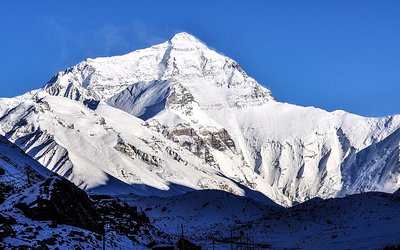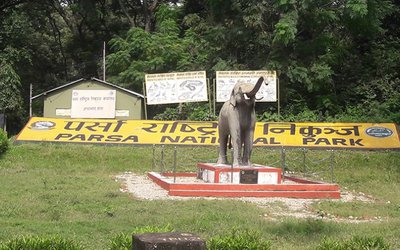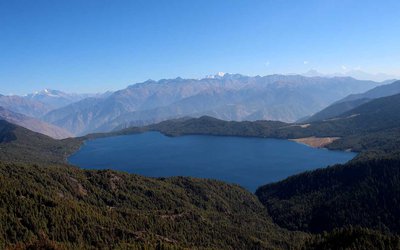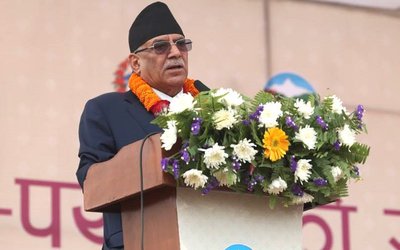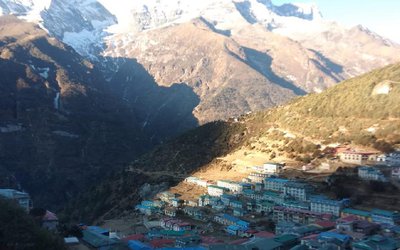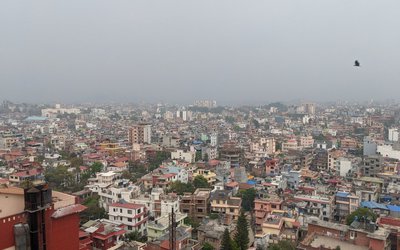Purposely allowing myself to get lost, I meander through some alleyways and side streets, and find myself in a bustling, crowded market street. I think I am somewhere East of Thamel, but my sense of direction is never something to be trusted.
People are stringing shimmering decorations between the two sides of the street, carefully lofting them above their heads, and over the heads of the shoppers, bikes and cars that are passing, I assume in preparation for the upcoming festival. There is an atmosphere of fun and excitement, and I am very aware that I am not in a touristy area – this is where the locals come.
So often in beautiful situations, there might be something missing, but here, in the small streets of Kathmandu, teaming with people – there is one thing too much traffic.
Even in the smallest of alleys that I pursue, ones that are not more than two metres across, there are motorbikes noisily squeezing through, kicking up dust onto the jewellery storefronts, as small children jump out of their path. How do people shop here, never being able to relax? Always being on their guard? I know that I am not used to always looking around me when I shop, a habit formed from the luxury of large pedestrian walkways that line shop windows and store fronts.
So many places in the world have areas of busy shopping precincts or business centres that are void of traffic. I pass the Sari shops and copper wares, and wish that I could enjoy the experience without always wondering whether my heels are going to be ridden into by a rickshaw, and without having to always be looking around me – am I in a motorbikes way? Should I walk on the left of that person coming towards me, or will that put them in the line of the taxi coming up behind me?
Think about Thamel, and its negatives. There are no sidewalks, there is traffic, there is dust, immense noise pollution, and there are sometimes overly forceful vendors. And people, there are a lot of people. Take out the traffic – even just 80% of it, allowing rickshaws, bicycles and the vehicles of business owners and residents to remain – and what you have is a clearer, cleaner shopping precinct that can be truly enjoyed by tourists. People could walk at whatever speed they wished, not feeling hurried along by the movement of cars and motorbikes pushing them in certain directions. And people could peruse every store from the outside first, evaluating whether they want to look inside, not wondering whether a taxi pushing past will force them up onto a shop doorstep and into the arms of an excited vendor.
And the silence – well, silence compared to the cacophony of a hundred honking horns – imagine the experience of this lively, exhilarating part of Kathmandu without the constant sounds of car horns?
Other areas too, like the market street that I wander through – would it not be better to limit the amount of traffic streaming through these busy streets, and protect the store owners’ products somewhat from the damage of the dirt and dust? And those tiny alleyways – surely they could be off limits for safety’s sake?
Perhaps I am looking at this all through an outsider’s eyes – but I can only see positives in limiting traffic to certain streets. People will always find taxis – and taxi ranks could be arranged so the tourists always know where to find one, and drivers would receive work fairly based on who is first available. Noise, dust and damage to sellers’ wares would decline, and tourists (and perhaps locals too) would overall enjoy their Thamel shopping or dining experience to a greater degree.
Jacqueline Damen is an intern from Australia. She can reach at jacquelinemdamen@gmail.com
- TANAHU HYDROPOWER PROEJCT: A Significant Achievement
- Apr 15, 2024
- AMBASSADOR HANAN GODAR: Sharing Pain With A Nepali Family
- Mar 30, 2024
- VISIT OF KfW AND EIB TO NEPAL : Mission Matters
- Mar 25, 2024
- NEPAL BRITAIN SOCIETY: Pratima Pande's Leadership
- Mar 24, 2024
- NEPAL ARMY DAY: Time To Recall Glory
- Mar 15, 2024

